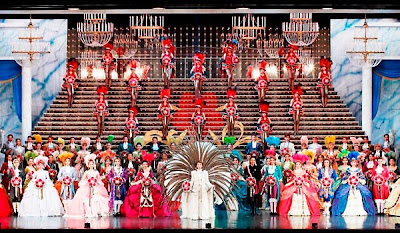Kyogen- Japanese Theater IV
 |
| Kyogen mask, Edo Period |
Many Kyogen plays are comedies, often mocking one of the main characters from the Noh play. They usually feature "trickster" characters, like foxes or tanuki (red raccoons). Foxes are generally shape-shifters, sometimes just playing silly tricks and other times outright malicious. Tanuki are best known for tricking people by paying for the tons of alcohol they drink with money that turns into leaves in the morning. They're also known for their ridiculous libidos, so clearly there's some satire going on here. (I'm guessing the butt of the joke here were young samurai or noblemen.)
 |
| A Kyogen fox, probably about to be trapped. |
 |
| Nothing stops truly resourceful servants from getting into the master's sake. From my class' Kyogen performance. |
The same technique was used in Europe in many Medieval romances. One of the earliest written Arthurian legends, Chretien de Troye's "Lancelot", actually reads as a comedy. Lancelot's love for Queen Guinevere is not the epic, emo romance we envision today- it was laughably silly, with him so caught up in pining for her he falls off his horse and almost drowns in a river at one point. But in the end he does prove to be a hero and saves the Queen (who has been kidnapped yet again. Seriously, the only royalty to be kidnapped more often than Guinevere is Princess Peach.) Like the samurai, knights in Medieval Europe were scary figures who needed to be humanized in this way to establish trust with the lower classes.
Take a moment to visualize the situation:
 |
| Scary samurai incite rebellions with their scariness!! |
 |
| Chill samurai live in harmony with lower classes because of their awesome chill-ness. |
Other posts on Japanese Theater:
Photo credits: Kyogen fox from the-noh.com. Scary samurai from Samurai Gallery & Musashi comic by amazing comic artist Kate Beaton. If you haven't read her comics, go do it now!


Comments
Post a Comment